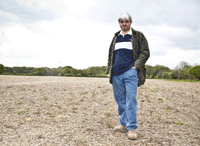Mixed results from new attempt to grow soya in UK

Kent grower Simon Chiles says drought conditions thwarted his chances of growing a successful soya crop last season, although he did achieve yields of up to 3.1t/ha.
He was one of four UK growers giving the crop a go under UK conditions, under a seed growing contract with Soya UK.
The soya was direct drilled into wheat stubble to try to retain the moisture in the seed-bed, but drought conditions prevented the crop from growing vigorously on his heavy soils. “We had hardly any rainfall from a couple of weeks before I planted it in late April until August and the crop suffered as a result,” Mr Chiles says.
Crop yields for Mr Chiles were extremely variable within the same field, says Soya UK managing director David McNaughton, ranging from as low as 0.74t/ha to 3.1t/ha.
Mr Chiles direct-drilled 16ha in two fields at a rate of 125-150kg/ha at a 120ha unit he shares farms in Edenbridge. The crop yielded a total of 10t at £450/t, less the growing costs of around £250/ha.
Soya bean proved to be a low input crop. “No fertiliser was applied just a bit of P&K.” But the crop was low growing and he admitted it would have benefited from a small dose of nitrogen to get it growing quicker and taller.
He sprayed the seed-bed with Round Up (glyphosate) and Stomp (pendimethalin) to clean up the weeds before drilling. Both fields of soya grew fairly well, but the second field suffered from a heavy weed burden. The registration in the UK of SU chemical thifensulfuron-methyl could help in future. “It’s used on the continent to control weeds in soya, but it’s not available here yet,” he adds.
The crop was successfully combined in September with a conventional header, having been dessicated with Reglone. Mr Chiles, who first grew soya nine years ago, knew from past experience that it is possible to harvest soya with a conventional header. “This year we ended up leaving some pods behind because they were low to the ground due to the drought,” he adds.
Mr McNaughton is looking to attract more than 50 growers in 2011 and increase his area of soya growers from 45ha last season to more than 405ha.
“The outlook for growing soya in 2011 is good. The price has jumped again and a tonne of soya is now worth around £400, which is a good return for a nitrogen-fixing break crop with a gross margin of around £300,” he says.
“Growing soya is not ideal for everyone – especially on heavy soils in a drought year like Simon experienced – but if you establish the crop well you can get the yields.”
Plastic assists establishment
Growing soya under plastic could solve the establishment problems associated with the crop, believes Lincoln-based forage specialist Jim Sheriff.
Mr Sheriff grew a small area of soya (0.1ha) under plastic last season on medium loam soils under a contract for Soya UK – and returned average yields of 3t/ha.
“The biggest problem with growing soya is getting the establishment right,” says Mr Sheriff. “You will likely be faced with a dry seed-bed at drilling time around the end of April and the pigeons and rabbits just feed on the crop. But by growing it under a plastic film you lock in more moisture and also keep the pests off.”
Using plastic increases growing costs by £280/ha, but he thinks it is worth it if it increases yields.
For next year, Mr Sheriff planning to grow 6ha under plastic. “I’ll be growing different varieties and trying out different strategies and fertiliser regimes, including applying nitrogen to get the crop going, to see if they make a difference,” he says.
SS2011
